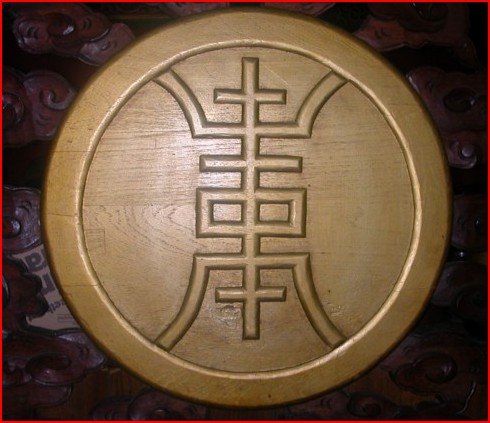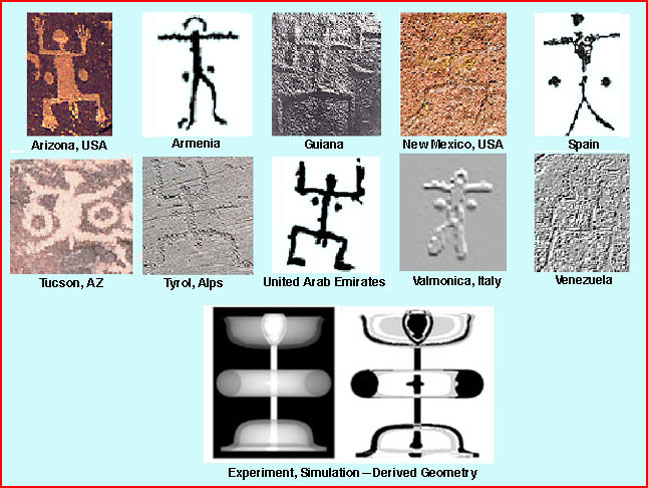
home
thunderblogs
forum
picture of the day
resources
team
updates
contact us
The staff posting the
picture of the day is taking a week
long respite to focus on important new developments.

Credit: Michael Armstrong & C.J. Ransom

Credit: Anthony Peratt, IEEE
Transactions on Plasma Science
pic of the day
archive
subject index
abstract
archive
Links:
Society for
Interdisciplinary
Studies
Oct 14, 2005
Chinese Longevity Symbol
This symbol will be found in most Chinese restaurants, and even in some Chinese homes. The symbol in the picture above is a stylized version of the "squatter man" or "stick man", themselves stylized derivations of the plasma formation seen in the sky by the ancients.
Sometimes thought to mean "good luck", the golden symbol above is an early script for the Chinese word pronounced shou, meaning "longevity". It's an old custom to present a "Picture of a Hundred Longevity" where literally one hundred different scripts of the character are written or embroidered in an artwork of calligraphy. This is done as an artistic, and usually expensive, birthday gift to a prominent or important figure at his birthday feast.
The Axis Mundi, a polar plasma discharge witnessed by the ancient myth-building people of the earth, went through several evolutionary stages of forms known as "plasma instabilities" in the laboratory. The form that we see as the "Stickman" or "Squatterman", is the culmination of a late phase, as a number of the flattened toroids fold up to form the stickman's head.
This squatter figure is one of the more stable plasma instabilities. Hence the association long life. This was the major part of the column, the brightest, the most terrifying. And of course it was recorded by everyone everywhere and influenced them deeply.
The "squatter" or "stickman" was recorded in nearly every culture. For example. it plays a dominant role in the Dogon Religion. Other cultures speak of it as the big red man in sky, .
Comparative mythologist David Talbott relates the Chinese image to a complex of motifs in ancient Egypt. He says:
"So what is the relationship to the principle of 'longevity'? The Egyptian Djed, 'ladder' of heaven, and 'backbone' present the nuances of endurance, stable support, and a continuation of life. They refer to the stable character of the stacked tori--part of the 'backbone' and 'ladder' motif. In this they stand as a contrast to the violent and wildly unstable phases that preceded it, including celestial wandering.
"The raising of the Djed was synonymous with the restoration
of Osiris to life after a chaotic period including death, disappearance,
and dismemberment. Equivalence with the backbone and ladder can be
established beyond dispute. In his restoration to life, Osiris
displays the ladder as his backbone, and both symbols find expression as
the Djed, which means stability, endurance, etc.
"The 'dismemberment' of Osiris' body means the same thing as the
hacking up of the chaos serpent, whose body becomes the horizontal bars
of the Djed AND the horizontal bars of both the backbone hieroglyph AND
of the ladder of heaven (all symbolic variants of the same celestial
form). The body of the upward- winding serpent (around the cosmic
column) came to be divided into a series of stacked tori."
We see this formation in the experimental plasma tests as do the Russians. See Kukuskin's skeleton plasma universe papers that he is prolifically publishing.
Contributed by Michael Armstrong
EXECUTIVE EDITORS:
David Talbott, Wallace Thornhill
MANAGING EDITOR:
Mel Acheson
CONTRIBUTING EDITORS: Michael Armstrong, Dwardu Cardona, Ev Cochrane,
C.J. Ransom, Don Scott, Rens van der Sluijs, Ian Tresman
WEBMASTER: Michael Armstrong
Copyright 2005: thunderbolts.info